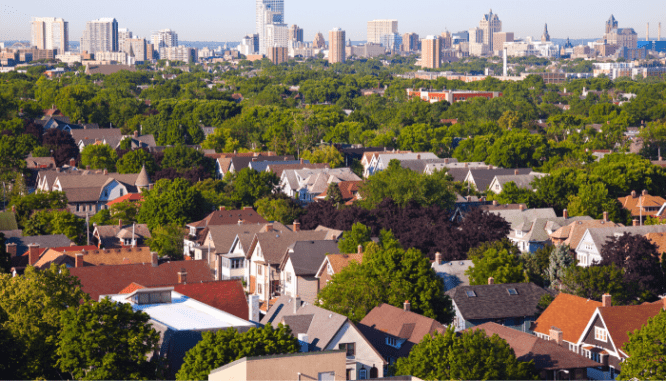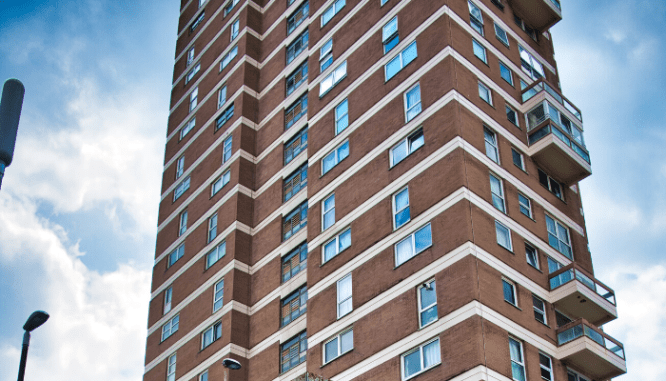How to Buy a House in Milwaukee, From Downtown to Lake Country
- Published on
- 5-6 min read
-
 Rachelle Dragani Contributing AuthorClose
Rachelle Dragani Contributing AuthorClose Rachelle Dragani Contributing Author
Rachelle Dragani Contributing AuthorRachelle Dragani is a freelance writer based in Brooklyn. Her work in the home and lifestyle space has appeared in publications including Gizmodo, Popular Mechanics, Yahoo, Bob Vila, Hunker, and more.
To the rest of the world, it’s all beer, cheese, and iconic TV characters. But Milwaukee locals know there’s a lot more to love about this hidden Midwestern gem.
Some Milwaukee homebuyers, in fact, feel spoiled for choice. There are so many affordable homes in top-notch neighborhoods that finding the perfect place will be overwhelming, and buyers need to understand the wear and tear of Milwaukee winters.
It’s always difficult to know where to begin when you’re ready to buy a house. But we’ve done the preliminary hard stuff: Talked to experts in Milwaukee real estate, scoured the area for the best of downtown and the burbs, and did the math to find the best recommendations for your budget and lifestyle. Then, we put them all together in this comprehensive guide.
You can figure out where and when you should be shopping, how to guarantee you’re getting only the best of Milwaukee’s older housing stock, and the best way to get hot tips on homes for sale (hint: It involves Midwestern friendliness, not a thankless Internet search).

Shopping for Milwaukee homes: What to look for
About 44% of Milwaukee’s homes, an estimated 70,000, were built before 1951, with others as far back as the 1800s. Aldred Walters, the home inspector at Walters Home Inspection, wants buyers to know that home inspections before buying are essential on these homes.
“Some of those older homes have structural cracks that need to be addressed, and others have issues with insulation,” he says. “In Milwaukee, metals are also a huge issue, so you need to make sure the plumbing systems are in order.”
He notes it’s best to find a general inspector who has connections to electrical and plumbing specialists to make sure that you’re not saddled with replacing complex systems as soon as they move in.
“Some people can get in over their heads, trying to dive into the market and not really understanding what they’re taking on with older properties,” says real estate agent Justin Ippoliti, who’s helped sell almost 300 homes in the area.
If a home was built before 1951, you may also want to have the water source tested for lead contamination. Milwaukee has launched efforts to replace contaminated pipes, so the cost might not necessarily fall on current homeowners or new buyers, and other measures (including water filters) can be put into place to avoid danger.
However, the city’s replacement process has been riddled with inefficiencies, so you’re better off knowing what you’re getting into with potential contamination before you buy.
Ippoliti says that many of his clients are surprised by the timeless charm of the older homes, and that many get to work with talented decorators who add modern touches of elegance and convenience while maintaining the home’s original integrity.
“They’re putting some modern features to combine with the beautiful character that you can’t find in new construction,” he said.
“They’re using the hardwood, the crown molding, and all those other features you see that just make a home scream ‘character.’”
For newer buildings, especially in booming downtown neighborhoods like the Third and Fifth Wards or the new “Deer District” by the Fiserv Forum, make sure you’re not getting drawn in by buyer incentives from eager developers that turn out to contain hidden fees or services you’ll never use.
You can work with your agent to prioritize the types of perks you want from a condo in a new development — such as parking spaces, a gym, or outdoor space — and find a building that gets you what you’ll use without charging you for what you won’t.

Get to know the lay of the land in Milwaukee: Which neighborhood suits you?
One aspect that surprises many Milwaukee newcomers is how accessible the downtown area can be from the suburbs. Relatively light traffic and a geographically small downtown area make travel within the greater Milwaukee area much easier than comparably sized cities. Plus, a cost of living that’s 11% lower than the national average make splurging on a dream home a little easier.
Here’s a quick look at some of the neighborhoods and suburbs in the Milwaukee area:
Downtown:
Thanks to development like the new Fiserv Forum, downtown condominiums are attracting a host of first-time buyers, such as young professionals looking for a small place of their own or an investment property, or for seasoned buyers looking for services like community activities and a concierge service.
You may be able to walk to work, or to great places to spend the afternoon or grab dinner, like the Art Museum and the Harbor House.
Milwaukee County:
If you’re looking for a home rather than a condo, you’re able to find great single-family home deals in up-and-coming areas such as West Allis, Silver City, Havenwoods, and Bay View.
There, you’re still within a 20-minute drive of downtown, the lakefront, and the area’s hottest neighborhood for young, diverse families and inventive restaurants.
You’ll find a wide variety of home types, including duplexes, brick ranches, Cape Cod homes, and single-family homes starting lower than $100,000 in these areas as of December 2019 (though expect to pay more in the super-desirable Bay View).
Public buses and a brand-new streetcar have also made it easier to bop around town from these areas, though area residents overwhelmingly use their own transportation to get to work.
Milwaukee County border:
Taxes vary wildly between Milwaukee neighborhoods and counties, but Milwaukee County has the highest taxes, sometimes twice as high as nearby Waukesha County.
Ippoliti suggested looking for deals right on the border of Milwaukee County, in areas like New Berlin and Butler.
There, great deals on single-family homes and ranches can sneak in under the radar, making both mortgage and tax payments low.
There’s also quite a bit of opportunity to get four-plus-bedroom homes in New Berlin in the $225,000-plus range as of December 2019, and 2 or 3-bedroom homes as low as $140,000 in Butler.
New Berlin in particular has a great school district, and commutes to downtown in these burbs can be as little as 15 to 20 minutes depending on where you work.
Lake Country:
Suburbs such as Oconomowoc, Pewaukee, Delafield, Merton, Okauchee Lake, and Lac La Bell are all included in the area known as Lake Country. It’s popular for, well, the lakes, which are gorgeous and accessible.
You can find four-plus bedrooms with large backyards or lake access in the $250,000 to $400,000 range as of December 2019, as well as sprawling lakeside mansions upward of $400,000 to $1 million in these areas, especially in Pewaukee, Chenequa, and Oconomowoc.
But you can also find comfortable townhouses in the $130,000 to $200,000 range off the lake. It’s a bit of a longer commute to downtown Milwaukee from here, but at less than an hour, it’s still doable for work. Plus, the extra space and access to thriving downtown areas in Oconomowoc (not to mention the giant shopping centers in Delafield) won’t have you missing Milwaukee proper on nights and weekends.
Northern suburbs:
Areas like Shorewood and Whitefish Bay are full of stunning older homes that make Architectural Digest readers drool, like stone Tudors, Cape Cod houses, and preserved Colonials that are physically close to each other, making it easy to get to know your neighbors.
As you venture into Mequon, Brown Deer, and Bayside, you’ll start to find more mid-century modern ranches and newer custom-built homes with high ceilings and big, private backyards.
Between the phenomenal school districts and easy access to both the lake and downtown, prices can easily go $350,000+ for three or more bedrooms as of December of 2019, but can dip down in the $200,000 range the further away you get from the lake.
Milwaukee has a commitment to growing industries like healthcare and technology, and this area attracts many of those workers.
Western suburbs:
The hottest suburb to the west of Milwaukee is Wauwatosa, thanks to bordering downtown, fun bars, and restaurants, a young crowd, a great school district, and homes rich in character.
Stone bungalows, Tudors, and brick ranches are all physically close together, fostering a vibrant sense of community in Tosa. Branching out to nearby areas like Elm Grove and Brookfield will add 10 to 15 minutes to your drive to downtown, and also come with higher home prices (expect to start around $215,000 as of December 2019 and rise steeply from there), but you’ll also get more backyard space and some of the best schools in the state.
For more affordable two-story colonials and mid-century modern ranches, check out areas like Muskego, Big Bend, Franklin, and Hales Corners, though keep in mind the latter two fall in Milwaukee County, where taxes are higher.
Agents are your best resources for finding homes that meet your needs in Milwaukee, but in an area full of Midwestern friendliness and proud natives, local real estate experts also recommend word of mouth for getting hot tips on real estate prices and unexpectedly charming neighborhoods.
Putting out feelers via social media or at work could guide you towards the house that winds up being your home.
It’s not uncommon for first-time buyers to submit multiple offers in competitive neighborhoods like Wauwatosa and Shorewood, said Ippoliti, especially. The process may be frustrating. But he said he’s seen clients who found options that fit their needs even better once they were forced to look at the variety the Milwaukee area offers.

Pro tips for Milwaukee buyers: When to buy and how to find a great deal
Agent Ippoliti says the Milwaukee market is so healthy that it’s smarter to buy than rent.
“A home you buy now doesn’t have to be your forever home,” he explains.
For potential buyers interested in owning but unsure about covering a mortgage on their own, Ippoliti suggested duplexes, a Milwaukee architecture staple.
“For the investor market, there’s a lot of really good duplexes that are great for returns,” he noted. “You can buy a duplex for $100,000 that’s ready to rent, and probably produce $700 or $800 of rent per unit.”
There are deals to be had year-round, but the best times to buy are January through March. June and July are tougher months to get good deals.
That’s especially true in areas with excellent school districts like Brookfield, Shorewood, and Pewaukee, since more homes go on the market as families pack up to relocate before a new school year gets into swing.
One exception to this rule? Downtown condos and investment properties. Rapid new growth in this market, combined with an ever-evolving group of sellers ranging from young professionals upgrading to retirees downsizing, make the downtown Milwaukee condo market robust all year.
Sync up with a top buyer’s agent to navigate the Milwaukee market
A great buyer’s market sometimes leads buyers to believe they don’t need an agent. But in an area with as much new downtown growth as Milwaukee, where developers often offer a host of incentives for new buyers, an agent can help you determine which of those deals are real and which don’t live up to the hype.
Or, if you’re interested in purchasing an older home, an agent can help recommend the professional inspections you’ll need to make sure you’re not in over your head with renovation projects.
Plus, they can help you save a huge chunk of change. In Milwaukee, top buyer’s agents help buyers save an average of $44,545 on a home.
Not sure where to start your search? HomeLight’s agent-matching platform can help connect you to the buyer’s agent who will listen to your needs, sift through the deals that really are too good to be true, and ultimately make buying your next home as delightfully breezy as a day on the Milwaukee lakefront.
Header Image Source: (Jayne Lipkovich/ Shutterstock)

